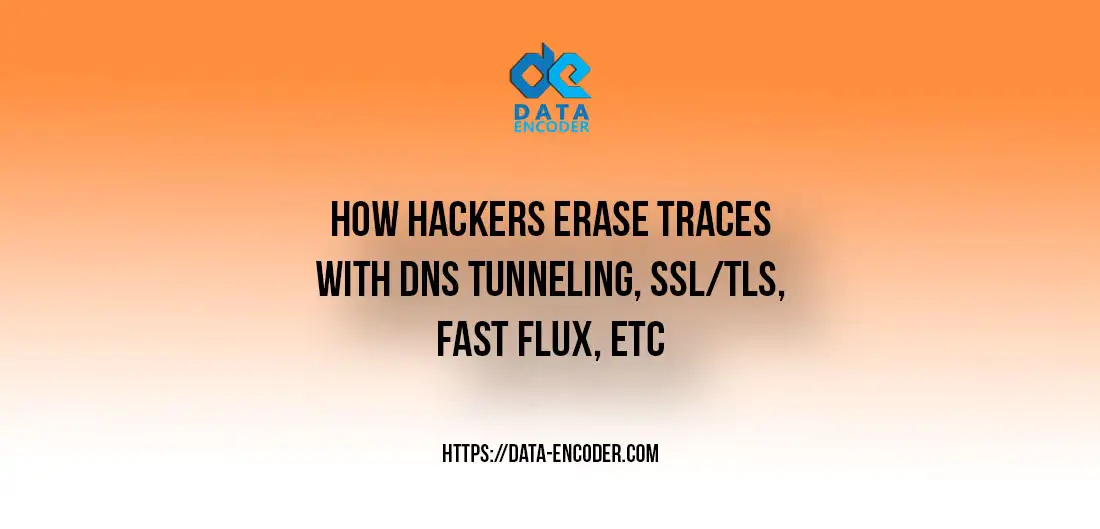Hackers erase traces using sophisticated methods. They employ DNS Tunneling, Cloudflare’s proxified DNS, and SSL/TLS with Fast Flux DNS. Additionally, they utilize Domain Generation Algorithms (DGAs), IP spoofing, port hopping, and polymorphic crypter techniques.
What is the purpose of these techniques and methods?
Hackers use complex methods to erase traces of themselves, such as IP or DNS.
Security systems and antiviruses always check the network, IP, and DNS status and block suspicious items. But hackers also use advanced, updated methods to persistently access the victim’s system without keeping a trace. This article will review the role of Cloudflare and proxified DNS, DNS tunneling with SSL/TLS, Domain Generation Algorithms (DGAs), IP spoofing, port hopping, and polymorphic crypter.
Which technique do hackers use to erase traces?
This section reviews the undetectable methods attackers use to hide their presence and identity.
In summary, you need to know that free tools such as free malware, free fud crypter, free rat software, or other free tools such as ransomware and stealer may fail to establish untraceable safe actions. Because these advanced methods require you to be professionally familiar with network knowledge, secure communication, professional programming, and how to bypass antiviruses, cryptography, or other tools in Linux (in some cases).
In other words, you may also use these methods and techniques with free tools and top malware 2022.
Still, there is no guarantee that malware or your identity will be detected.
Because security systems and antiviruses, especially Windows Defender, have flagged the core and modules of free tools.
Therefore, if firewalls or antiviruses see this suspicious file, the possibility of reporting your IP and DNS will be very high.
But don’t worry; we are trying to explain these techniques to you very simply so that you can quickly learn how to work.
In short, these methods with clean spreading methods like spreading malware on Github or Google give longer FUD results.
What is DNS Tunneling, and how do you set it on Cloudflare?
DNS tunneling is a method that transmits data through the DNS protocol by encapsulating it within DNS queries and responses. This process is often to bypass security controls that limit certain types of network traffic or to exfiltrate data from a compromised system.
We recommend watching how to open port forwarding before starting.
You can setup DNS tunneling with Cloudflare or other DNS services with the following steps:
1. First, Register a domain name for the tunneling. Set it up on Cloudflare and hide the domain IP with the proxified DNS option. Note that your domains and subdomains will communicate between the client and server.
What are Domain Generation Algorithms (DGAs)?
Domain Generation Algorithms (DGAs) are a technique used in malware to generate many domain names to communicate with command and control servers.
Note most malware, such as free malware, doesn’t have these functions. It would help if you fixed it with your DNSs. This technique needs more explanation and more time. In short, you can skip Step 2 if you need to learn about it. As mentioned before, this article is for professionals.
In short, DGAs use a mathematical algorithm to generate many domain names based on a combination of variables, such as the current date, time, and other system information. This algorithm prevents domains from being blocklisted or monitored.
We recommend watching how keep connection with FUD crypter too.
Therefore follow these:
2. Configure the domain to use a DGA, allowing the domain name to change automatically and making it harder for antivirus and firewalls to identify and block the traffic.
3. Install a DNS tunneling tool, such as Iodine or Dns2tcp or Dnscat2 or Clobber or Dns2socks, etc., and set up a DNS tunnel between them over the Cloudflare proxified DNS domain. It will encapsulate and send the data as DNS queries and reactions.
4. Install and configure NGINX on the server machine to act as the target server’s reverse proxy or load balancer. Configure NGINX to accept SSL/TLS connections on your specified port.
5. Install and configure an SSL/TLS certificate on the NGINX server to enable secure client communication.
6. Configure NGINX to proxy traffic to the target server using SSL/TLS encryption.
What is Fast Flux DNS, and how do you set it?
Fast Flux DNS (Domain Name System) is a method used by malware authors to hide the actual location of their command and control servers (C&C servers). Botnets use this technique to manage bots. So if you don’t need it, skip this too.
In Fast Flux DNS, the IP address associated with a domain name changes rapidly, often within a few minutes, making it difficult for security researchers and law enforcement agencies to locate and take down these servers.
7. Configure Fast Flux DNS on the Cloudflare proxified DNS domain to rapidly change the IP address associated with the domain name. You can do it by configuring multiple A records with short TTL values and using load balancers or other techniques to switch between them quickly.
8. Test the SSL/TLS tunnel, DNS tunnel, and Fast Flux techniques to ensure that traffic is encrypted, that data can be transmitted securely between the client and target server, and the IP address associated with the domain name can be rapidly changed.
In short, explore the range of tactics hackers utilize for DNS tunneling and distributing malware in 2024, such as leveraging social engineering. It’s essential to elaborate on these approaches and rephrase them to ensure uniqueness and readability.
Can Rat Software use DNS Tunneling with SSL/TLS?
The answer is yes. Remote Access Trojans (RATs), Stealer, Ransomware, Keyloggers, Loaders, and zero-day exploits use DNS tunneling and other mentioned techniques. Search for TROJAN.WIN32.DNSCHANGER, or Redline Stealer for example.
We recommend watching bypass Windows Defender with Rat software.
These malware types can use Fast Flux DNS, proxified DNS, and SSL/TLS to create a complex network to identify and block, allowing attackers to distribute and maintain the malware on the victim’s device. Using these methods, attackers can evade detection and avoid tracing back to their original location.
Hackers erase traces of their activity to bypass Windows Defender using top Rat software 2024. We suggest watching how they do it to understand the process better.
Removing Traces with IP spoofing or port hopping
Attackers may also use IP spoofing or port-hopping techniques to evade detection. Also, hackers erase traces by spoofing IP addresses, which means they forge the source IP of a packet to show it’s from somewhere else. Additionally, they use port hopping, switching port numbers for each packet. This tactic makes it harder for security tools to spot and block malicious traffic.
What do you know about Polymorphic crypter?
Polymorphic crypter is a top crypter software to encrypt the malware payload with an automatic STUB core maker, obfuscator, and more options. FUD crypter 2023 can bypass antivirus in Runtime but may get detections. But polymorphic crypter changes the encryption methods automatically to evade antivirus. You can use Crypter clone Code Sign Certificate to evade detections.
Finally, you can watch a video about bypassing Windows Defender to learn more about FUD crypter. Additionally, contact with our Telegram channel for further information and updates.







I want to learn more about Fast Flux,
Single Flux, Double Flux, Domain Flux.
All about that technical or how to set it up with more details.
If you can help me about that, Thanks you so much.
We will explain more about this in future articles.